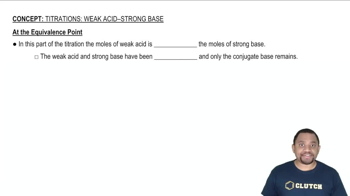Here are the essential concepts you must grasp in order to answer the question correctly.
Titration
Titration is a quantitative analytical technique used to determine the concentration of a solute in a solution. It involves the gradual addition of a titrant (in this case, HCl) to a solution of analyte (NaOH) until the reaction reaches its equivalence point, where the amount of titrant added is stoichiometrically equivalent to the amount of analyte present.
Recommended video:
pH Scale
The pH scale measures the acidity or basicity of a solution, ranging from 0 to 14. A pH of 7 is neutral, below 7 indicates acidity, and above 7 indicates basicity. In the context of titration, the pH changes significantly as the titrant is added, especially around the equivalence point, where the solution transitions from basic to acidic.
Recommended video:
Equivalence Point
The equivalence point in a titration is the stage at which the amount of titrant added is exactly enough to completely neutralize the analyte. For the titration of NaOH with HCl, the equivalence point occurs when the moles of HCl added equal the moles of NaOH present. This point is crucial for determining the endpoint of the titration and is typically indicated by a sharp change in pH.
Recommended video:




